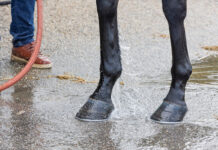Scratches, aka pastern dermatitis or “greasy heel”
Symptoms: Inflammation, swelling, redness and scaling primarily on the back of the pasterns and heels but sometimes on the entire lower leg; hair matting; serum oozing from the skin; crust (scab) formation; thickened skin; pain; and sometimes lameness.
What to do: Pastern dermatitis is not an emergency. An experienced owner can usually treat a mild to moderate case successfully. If your horse has a severe case, consult your vet, who can prescribe medication for the infection and pain.
To treat pastern dermatitis, clip the hair off the affected area and then gently wash the skin with warm water and Novalsan or Betadine scrub. Once you’ve softened the crusts, gently pick them off. Dry the skin completely, then apply an antibacterial moisture-barrier ointment available from your vet, or you can use diaper rash cream. Repeat this treatment once or twice a week (although you may need to apply the ointment more frequently) until the dermatitis clears up. If you don’t see significant improvement after a week or so, consult your vet.
Prevent recurrences by keeping your horse’s legs clipped and reducing the moisture content of his environment—for example, keep his stall clean and don’t turn him out in the mud.
Outlook: Pastern dermatitis usually responds well to treatment; recurrence is possible if the conditions described above recur.
Back to Horse Health Glossary
This article originally appeared in the 2012 issue of Horses USA. Click here to purchase the most recent issue.






